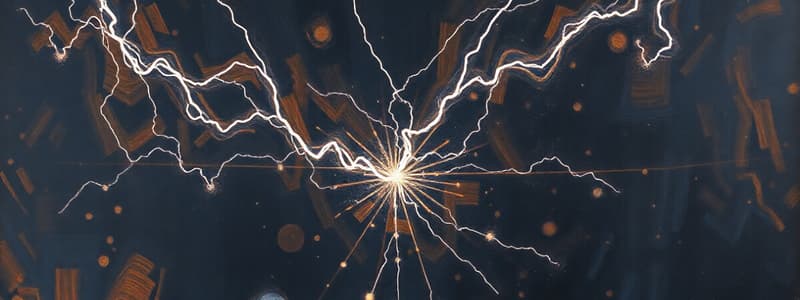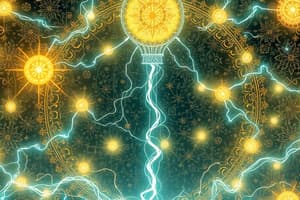Podcast
Questions and Answers
In electromagnetism, if electric charges can exist separately as purely positive or negative, what is the corresponding characteristic of magnetic poles?
In electromagnetism, if electric charges can exist separately as purely positive or negative, what is the corresponding characteristic of magnetic poles?
- North and South poles always exist together; magnetic monopoles do not exist. (correct)
- Magnetic poles can be temporarily separated under high voltage.
- Magnetic monopoles can be isolated and do exist in nature.
- The existence of monopoles depends on the material's permeability.
What is the relationship between magnetic flux density (B) and magnetic field intensity (H)?
What is the relationship between magnetic flux density (B) and magnetic field intensity (H)?
- $B = \mu H$, where $\mu$ is permeability. (correct)
- $B = \epsilon H$, where $\epsilon$ is permittivity.
- $H = \mu B$, where $\mu$ is permeability.
- $B = H/\mu$, where $\mu$ is permeability.
What is the correct formula to calculate Reluctance ($\Rm$) from a magnetic circuit, where MMF is the magnetomotive force and $\Phi_B$ is the magnetic flux?
What is the correct formula to calculate Reluctance ($\Rm$) from a magnetic circuit, where MMF is the magnetomotive force and $\Phi_B$ is the magnetic flux?
- $\Rm = \text{MMF} + \Phi_B$
- $\Rm = \text{MMF} / \Phi_B$ (correct)
- $\Rm = \text{MMF} \times \Phi_B$
- $\Rm = \Phi_B / \text{MMF}$
A magnetomotive force (MMF) is generated in a coil with 500 turns carrying a current of 2A. Calculate the MMF.
A magnetomotive force (MMF) is generated in a coil with 500 turns carrying a current of 2A. Calculate the MMF.
What is the unit of Permeability?
What is the unit of Permeability?
What parameter is analogous to permeability in electric fields?
What parameter is analogous to permeability in electric fields?
Which of the following equations correctly relates electric field (E) to the force ($\FE$) experienced by a charge Q?
Which of the following equations correctly relates electric field (E) to the force ($\FE$) experienced by a charge Q?
A particle with charge Q moves with velocity v in a magnetic field B. The force experienced is given by $FB = QBv \sin\theta$. Under what condition is the force maximum?
A particle with charge Q moves with velocity v in a magnetic field B. The force experienced is given by $FB = QBv \sin\theta$. Under what condition is the force maximum?
What is the correct formula to calculate the energy stored in an inductor ($\U_L$) given the inductance (L) and the current (I)?
What is the correct formula to calculate the energy stored in an inductor ($\U_L$) given the inductance (L) and the current (I)?
What is the unit of Magnetic Flux?
What is the unit of Magnetic Flux?
In the context of electromagnetism, what is the 'E-Field' conceptually?
In the context of electromagnetism, what is the 'E-Field' conceptually?
Which formula accurately calculates Capacitance (C) based on material properties?
Which formula accurately calculates Capacitance (C) based on material properties?
Given the equation for the Electromotive Force (EMF) as $EMF = -N\frac{d\Phi_B}{dt}$, what does this equation represent?
Given the equation for the Electromotive Force (EMF) as $EMF = -N\frac{d\Phi_B}{dt}$, what does this equation represent?
What are the units for electric flux density?
What are the units for electric flux density?
What is the formula for the resistance (R) of a material, given its physical properties?
What is the formula for the resistance (R) of a material, given its physical properties?
Flashcards
Permittivity
Permittivity
A measure of how much electric field is generated per charge.
Permeability
Permeability
A quality describing the level to which a magnetic field permeates a space or a specific material.
Electric Charges
Electric Charges
Fundamental property with positive and negative types that create electric fields.
Magnetic Poles
Magnetic Poles
Signup and view all the flashcards
Electric Field
Electric Field
Signup and view all the flashcards
Magnetic Field
Magnetic Field
Signup and view all the flashcards
E-Field
E-Field
Signup and view all the flashcards
H-Field
H-Field
Signup and view all the flashcards
Electric Flux Density (D-Field)
Electric Flux Density (D-Field)
Signup and view all the flashcards
Magnetic Flux Density (B-Field)
Magnetic Flux Density (B-Field)
Signup and view all the flashcards
Electric Flux
Electric Flux
Signup and view all the flashcards
Magnetic Flux
Magnetic Flux
Signup and view all the flashcards
Electric Force
Electric Force
Signup and view all the flashcards
Magnetic Force
Magnetic Force
Signup and view all the flashcards
Capacitance (C)
Capacitance (C)
Signup and view all the flashcards
Study Notes
- Unit 2 is about parallelisms of electric and magnetic quantities
Electric Quantities
- Permittivity is measured in Farad per meter (F/m)
- ε = εrε₀, where εr is the dielectric constant or relative permittivity of the material
- ε₀ = 8.8542 x 10^-12 F/m or 8.8542 pF/m
- Charges can be positive and negative
- They can exist separately as purely positive and purely negative charge
- Like charges repel, unlike charges attract
- Fields are defined by their actual field
- E-Field is derived from Gauss' and Coulomb's Laws using the formula E = Qin/(εΑ) = Fₑ/Q = kQ/r² and has units of N/C or V/m
- Flux Density is defined by the D-Field
- D = εΕ = Qin/A and the units are C/m²
- Flux is measured using E-Flux
- Φᴇ = ΕΑ cos θ, with units of V-m
- D-Flux is Φᴅ = ε Φᴇ = DA cos 0, with units of Coulombs (C)
- (F/m)(V-m) = F-V = (C/V)(V) = C
- Electric Force is calculated from Coulomb's Law
- Fᴇ = k|Q1Q2|/r² and from Electric Field Fᴇ = EQ and the units are Newtons (N)
- Electromotive Force (EMF) comes from Faraday's Law
- EMF = -N(dΦB/dt) and from Electric Field V = Er, with units of Volts (V)
- Resistance (R) is derived from material's physical properties
- R = (ρl)/A, and from Electric Circuits and Ohm's Law R = EMF/I = V/I, with units of Ohms (Ω)
- Capacitance (C) is derived from material's physical properties
- C = (εΑ)/r, and from Charge (Q) and Voltage (V): C = Q/V, with units of Farads (F)
- Stored Energy Capacitor (Uc) is derived from Capacitance (C) and Voltage (V):
- Uc = 1/2 CV², with units of Joules (J)
Magnetic Quantities
- Permeability is measured in Henry per meter (H/m)
- μ = μrμ₀, note that 1 T-m/A = 1 H/m
- μr is the relative permeability of the material and is unit-less
- μ₀ = 1.2566 x 10^-6 H/m or 1.2566 µH/m
- Poles are North and South
- One is found in each magnet's end, monopoles do not exist
- Like poles repel, unlike poles attract
- Fields are defined by their actual field
- H-Field: H has units of A/m
- Flux Density is defined by the B-Field
- B = μΗ, with units of T : Tesla (MKS) or G : Gauss (CGS)
- Flux is measured using H-Flux
- ΦH = HA cos θ with units of A-m for MKS and Oersted (Oe) for CGS
- B-Flux is ΦB = μ ΦH = BA cos θ with units of Weber (Wb) for MKS and Maxwell (Mx) for CGS
- Magnetic Force is calculated using B-Field Force
- For a moving charge (Q) moving with velocity (v): FB = QBv sin θ
- Inside a conductor of length (I) and current (I): FB = IIB, with units of Newtons (N)
- Magnetomotive Force (MMF) is derived from the Number of turns (N) and Current (I) in the coil
- MMF = ℱm = NI, with units of Ampere-Turns (A-t) or Gilberts (Gi), where 1 A-t = 1.2566 Gi
- Reluctance (Rm) is derived from material's physical properties:
- Rm = 1/(μΑ) and from magnetic circuit Rm = MMF/ΦB = (NI)/ΦB, with units of Rels = Ampere-Turns per Weber (A-t/Wb)
- Inductance (L) is derived from material's physical properties:
- L = (μΑΝ²) / /, with units of Henry (H)
- Stored Energy in Inductor (UL) is derived from Inductance (L) and Current (I):
- UL = 1/2 LI², with units of Joules (J)
Studying That Suits You
Use AI to generate personalized quizzes and flashcards to suit your learning preferences.




